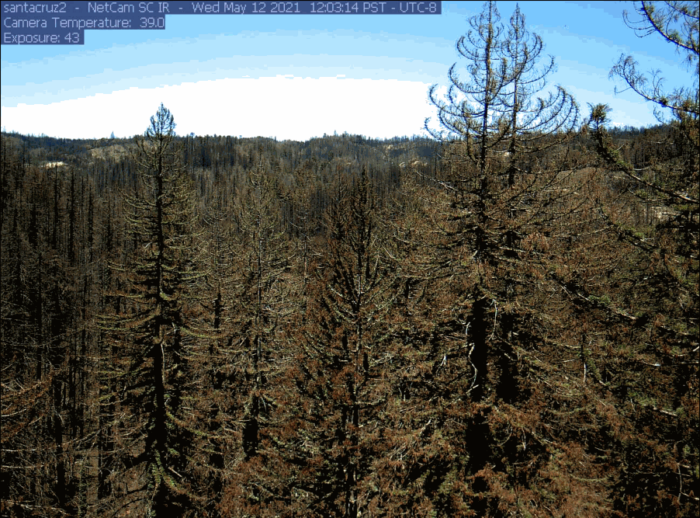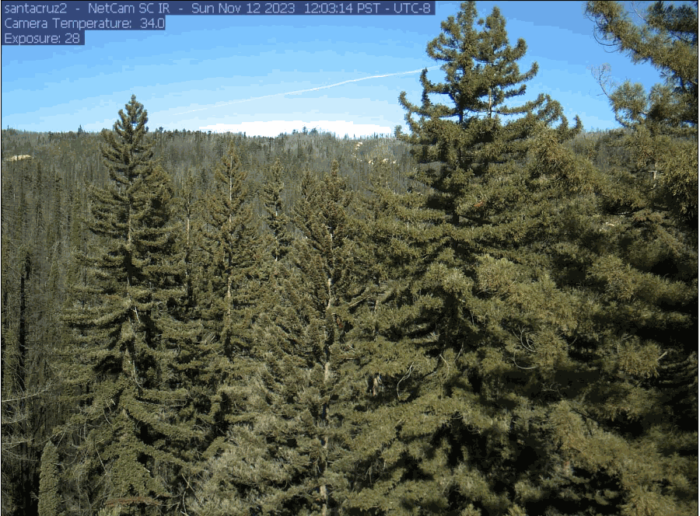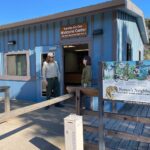
Media Contact:
Robin Carr, Landis Communications Inc.
Email: Redwoods@landispr.com | Phone: (415) 766-0927
Trees resprout from ancient buds—dormant under bark for centuries—and utilize decades-old carbon reserves
New canopy photos show prolific redwood tree regrowth since the 2020 CZU Lightning Complex Fires
San Francisco, Calif. (Dec. 1, 2023) — Save the Redwoods League and Northern Arizona University (NAU) have announced the discovery that ancient buds and decades-old carbon reserves drive prolific coast redwood tree regrowth after catastrophic wildfire. In a new multi-year study, published in Nature Plants, the research team observed these unique adaptations that helped old-growth redwood trees at Big Basin Redwoods State Park in California recover after the extreme 2020 CZU Lightning Complex Fires.
A time lapse shows redwood growth at Big Basin Redwoods State Park after the 2020 CZU Lightning Complex fires. PhenoCam Network, Phenocam.nau.edu and Mostafa Javadian, NAU
“Some of the results of this study suggest many of the redwoods at Big Basin were actually well prepared for this fire event,” said Drew Peltier, biologist and assistant professor at University of Nevada, Las Vegas (formerly at NAU). “Coast redwoods are extremely fire adapted and perhaps unusual in that they resprout after disturbances like fire. We were amazed to discover how they actually do that physiologically.”
“The CZU Fire consumed all of the leaves on some of the tallest and oldest trees in the world, yet many are recovering,” said George Koch, professor of biological sciences at NAU. “Redwoods’ scientific name is ‘sempervirens,’ which means ever-flourishing. It’s very satisfying to have learned a bit more about how this remarkable species lives up to its name.”
The research team from NAU collected samples of small redwood tree sprouts at Big Basin following the CZU fires. Using a mini carbon dating system (MICADAS) at NAU—a first-of-its-kind tool in the United States at an academic institution—the team measured the number of radiocarbon atoms in the samples to determine the age of carbon reserves used to grow new leaves.
They identified that the carbon reserves the trees used to produce the sprouts were more than a half-century old. They also found that many burned old-growth redwood trees resprouted quickly following the fire, and that these sprouts emerged from buds that had been dormant under the trees’ bark for centuries. Direct use of old stored carbon has rarely been documented and never before in such large, old trees. Some old-growth trees at Big Basin are more than 1,500 years old.
As part of the research endeavor, the team also installed phenology cameras in the tree canopy to monitor the regrowth over time. That ongoing monitoring is part of the PhenoCam Network, which tracks vegetation growth and phenology in ecosystems around the world.
“These images show, in a visually compelling and accessible manner, just how catastrophic the devastation from the CZU fires was. At the same time, they document the absolutely incredible resprouting that has occurred in a remarkably short period of time,” said Andrew Richardson, regents’ professor of ecosystem science at NAU. “This is in part thanks to the unusual anatomy of redwoods and their investment in large carbon reserves.”


Redwoods and Fire
“This fascinating research reveals how coast redwoods have been able to adapt and survive for millennia by drawing on carbon they’ve stored for decades to give them new life,” said Joanna Nelson, PhD, director of science and conservation planning for Save the Redwoods League, which funded the research. “These discoveries underscore why we have to protect the last remaining old-growth redwood trees, use best forest management practices and continue to restore younger second-growth forests—so they’ll have the capacity for resilience to future wildfires and other effects of climate change.”
Coast redwood forests are fire adapted and have been thriving, fire-resilient ecosystems for millions of years, but the CZU fires burned at an intensity not documented in most coast redwood groves for at least a century. While redwoods demonstrated a remarkable ability to recover post-fire, other common tree species of the coast redwood forest, including Douglas-fir, do not have the same capacity for regrowth and experienced nearly 100% mortality.
The CZU fires spanned more than 135 square miles in the Santa Cruz Mountains of Northern California, an area nearly three times the size of San Francisco. Notably, over 97% of Big Basin Redwoods State Park burned, including old-growth redwood forest. Many trees’ crowns, some more than 295 feet tall, lost all their canopy leaves. Sadly, many plants and animals perished, and the extreme fire behavior not only affected Big Basin, but also nearby parks and the surrounding communities.
Save the Redwoods League, California State Parks and a broad coalition of partners are working to study and restore the forest to increase its capacity for carbon capture, bring back forest biodiversity and build climate resilience back into this landscape through a coordinated, science-based approach.
Acknowledgements
The National Science Foundation and Save the Redwoods League provided funding for this scientific study. Special thanks to Joanne Kerbavaz, senior environmental scientist for California State Parks, who permitted essential early access to Big Basin, which made this research possible. Thanks also to Sempervirens Fund and Jim Campbell-Spickler, director of the Sequoia Park Zoo, for supporting the canopy camera installation to monitor the regrowth over time.
***
For more hi-res images and b-roll, please visit the League’s Media Resources page .
To schedule an interview, contact Robin Carr at (415) 766-0927or Redwoods@LandisPR.com.
This feature appears in the beautiful printed edition of Redwoods magazine, a showcase of redwoods conservation stories by leading scientists and writers, as well as breathtaking photos, and ways you can help the forest. Only a selection of these stories are available online.
Join our thousands of members today for only $25, and you’ll get future editions of our Redwoods magazine.
One of the nation’s longest-running conservation organizations, Save the Redwoods League has been protecting and restoring redwood forests since 1918. The League has connected generations of visitors with the beauty and serenity of the redwood forests. Our 400,000 supporters have enabled the League to protect more than 220,000 acres of irreplaceable forests in 66 state, national, and local parks and reserves. For information, please visit SaveTheRedwoods.org.
Tags: 2023, Big Basin Redwoods State Park, fire, Press Release, science, wildfires

